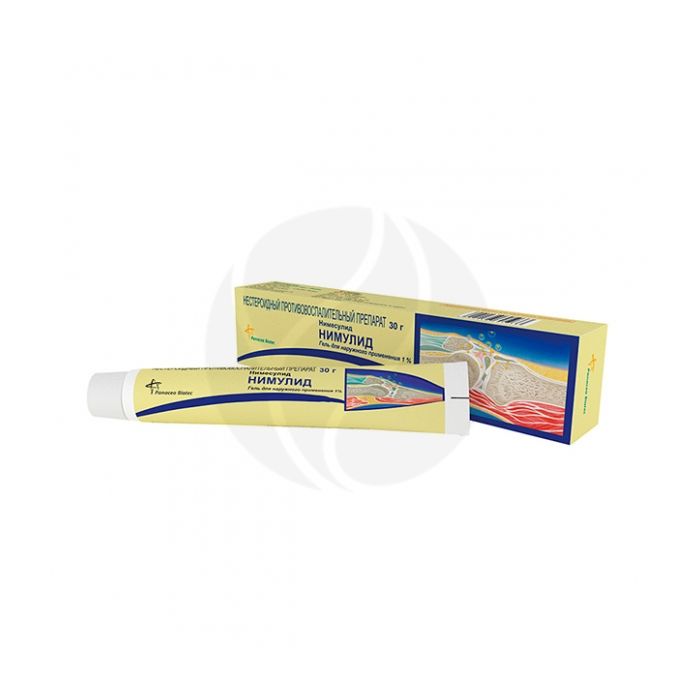Nimulide gel 1%, 30 g
Expiration Date: 05/2027
Russian Pharmacy name:
Нимулид гель 1%, 30 г
Local symptomatic treatment of inflammatory and degenerative diseases of the musculoskeletal system: articular syndrome with exacerbation of gout;
rheumatoid arthritis;
psoriatic arthritis;
ankylosing spondylitis;
osteoarthritis;
osteochondrosis with radicular syndrome;
radiculitis;
inflammatory lesions of ligaments, tendons, bursitis;
sciatica, lumbago;
muscle pains of rheumatic and non-rheumatic origin;
post-traumatic inflammation of soft tissues and the musculoskeletal system (damage and rupture of ligaments, bruises).
Applied externally, applied to the affected area 3-4 times / day.
Should not be used for more than 10 days without consulting a doctor.
Gel for external use 1% 1 g
nimesulide 10 mg
Hypersensitivity to nimesulide,
erosive and ulcerative lesions of the gastrointestinal tract in the acute phase,
bleeding from the gastrointestinal tract,
dermatoses,
damage to the epidermis and skin infections in the area of ??application,
severe renal failure (CC <30 ml / min),
severe liver failure,
an indication of a history of bronchospasm in connection with the use of acetylsalicylic acid or other NSAIDs,
pregnancy, lactation (breastfeeding),
children up to age 7 years.
Carefully
Liver failure; renal failure; severe heart failure; arterial hypertension; type 2 diabetes mellitus; old age, childhood.
pharmachologic effect
NSAIDs from the sulfonanilide class, a selective competitive reversible COX-2 inhibitor. When applied externally, it has a local anesthetic and anti-inflammatory effect.
Reduces the concentration of short-lived prostaglandin H2, a substrate for kinin-stimulated synthesis of prostaglandin E2, in the focus of inflammation and in the ascending pathways of pain impulses in the spinal cord. A decrease in the concentration of prostaglandin E2 (a mediator of inflammation and pain) reduces the activation of prostanoid receptors of the EP type, which manifests itself in analgesic and anti-inflammatory effects.
When applied externally, it causes a weakening or disappearance of pain at the site of application of the drug, incl. joint pain at rest and during movement, reduces morning stiffness and swelling of the joints. Promotes increased range of motion.
Pharmacokinetics
When applied externally, the concentration of the active substance in the systemic circulation is extremely low. Cmax after a single application is noted by the end of the first day, its value is more than 300 times lower than that for oral dosage forms of nimesulide. No traces of the main metabolite of nimesulide, 4-hydroxynimesulide, are found in the blood.
Side effect
Local reactions: itching, urticaria, peeling, transient discoloration of the skin (not requiring discontinuation of treatment).
Systemic reactions: when applied to large areas of the skin or with prolonged use, heartburn, nausea, vomiting, diarrhea, gastralgia, ulceration of the gastrointestinal mucosa, increased activity of hepatic transaminases are possible; headache, dizziness; fluid retention, hematuria; allergic reactions (anaphylactic shock, skin rash); thrombocytopenia, leukopenia, anemia, agranulocytosis, prolonged bleeding time.
Application during pregnancy and lactation
Contraindicated during pregnancy, during breastfeeding
Application for violations of liver function
Contraindicated in severe hepatic impairment.
With care: liver failure.
Application for impaired renal function
Contraindicated in severe renal failure (CC <30 ml / min).
With caution: renal failure.
Application in children
Contraindicated in children under 7 years of age.
The drug should be prescribed with caution in children over 7 years of age.
Use in elderly patients
The drug should be prescribed with caution to elderly patients.
special instructions
It is recommended to apply only to intact skin areas, avoiding contact with open wounds.
Should not be used under airtight dressings.
Drug interactions
Pharmacokinetic interaction with drugs competing for binding to blood plasma proteins is not excluded.
Nimesulide should be used with caution along with digoxin, phenytoin, lithium preparations, diuretics, cyclosporine, methotrexate, other NSAIDs, antihypertensive and hypoglycemic agents.

